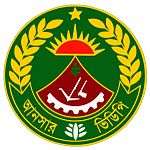Bangladesh Ansar
| Bangladesh Ansar | |
|---|---|
| বাংলাদেশ আনসার | |
 | |
| Active | 1948–present |
| Country |
|
| Allegiance | Bangladesh |
| Type | Internal Security, Law Enforcement, Gendarmerie |
| Size | 6.1 million |
| Garrison/HQ | Gazipur, Bangladesh |
| Nickname(s) | BA |
| Anniversaries | 26 March |
| Engagements | Bangladesh Liberation War |
| Decorations |
1. Bir Sreshtho 2. Bir Uttom 3. Bir Bikrom 4. Bir Protik |
| Commanders | |
| Director General | Major General Mijanur Rahman Khan[1] |
The Bangladesh Ansar (also known as the Ansar Bahini) is a lightly-armed volunteer paramilitary force for the preservation of internal security and law enforcement in Bangladesh. It is administered by the Ministry of Home Affairs of the Government of Bangladesh.[2][3] The name originates from the Arabic word of "Ansar", which denotes a "helper" and specifically refers to the companions of Muhammad, the prophet of Islam, during his exile from Mecca.[2][3]
History
The Ansar were formed out of the remnants of the Indian Home Guard who were from East Bengal, which had become a part of Pakistan after the partition of India in 1947.[3] The force was formed as the "East Pakistan Ansars" by the East Pakistan Ansars Act of 1948, and officially launched on 12 February 1948.[3] The first director of the Ansar was James Buchanan, a British official appointed by the government of then-Chief Minister of East Bengal Khawaja Nazimuddin.[3] The force was placed under the administration of the home ministry of the province of East Bengal (later known as East Pakistan).
The emphasis was on recruiting in border areas, where Ansars were deployed to interdict smuggling, prevent emigrants from taking valuables out of the country illegally, build border roads, and conduct occasional raids into India. The force grew quickly. By early 1949 there were 118,000 Ansars. According to historian Willem van Schendel, the Ansars "soon earned a reputation for intimidation and hooliganism, especially with regard to the non-Muslim inhabitants of East Pakistan."[4] During the Indo-Pakistani War of 1965, the Ansar were deployed to the border areas along with the East Pakistan Rifles to support the Pakistani army.[3]
Post-independence
During the Bangladesh Liberation War of 1971, most of the Ansar joined the Mukti Bahini guerrillas to fight against the Pakistani army.[3] After the independence of Bangladesh, the force was reconstituted as the Bangladesh Ansar. The Ansar were given fresh importance by the government of President Ziaur Rahman, which designated the Ansar as the "people's defence force" and formed Ansar battalions.[5] A Gazette listing the name of freedom fighters, who fought against the Pakistani army during liberation war 1971, was published by the Government of the Peoples Republic of Bangladesh in 2003. Prime Minister of Government of the Peoples Republic Of Bangladesh awarded the respected family member of Martyrs of Ansar & VDP organization on 22 October 1997. With the remembrance respectfully about the proud contribution of the respected family members of Martyrs of this organization in the Great Liberation war, Ansar & VDP invited them in the Award giving ceremony of Ansar & VDP Academy, Shafipur, Gazipur, Dhaka.
Raising of Ansar battalions
In 1976, 20 Battalions of Ansar were raised in line with the Armed Police Battalions to augment the strength of the security forces. At present, there are 36 Male and two Female Ansar Battalions deployed all over the country. Battalion Ansars are mainly deployed in Chittagong Hill Tracts (CHTs) for Counter Insurgency Operations (CIO) and south-western region of the country for Counter Terrorism Operations. In the regular process of evolution, members of Ansar Battalions are gradually being upgraded to the regular force of this organization. Their service is brought under National Pay Scale, they are getting family ration and they have got combat uniform since 15 October 2008.[3]
Mission and organisation
There are three stated missions of Ansar: (1) To assist police in maintaining law and order, (2) To assist Bangladesh Armed Forces in national defence in wartime and (3) To take part in socio-economic development projects.[3] The Ansar are headed by a director-general, who also heads the Village Defence Party (VDPs). Major General Md Nizam Uddin was appointed director general in December 2012.[6] The headquarters of the Ansar is located in Dhaka and the Ansar Academy is located at Shafipur Gazipur, north of the national capital, Dhaka.[5] The Ansar often operate alongside the Bangladesh Army and the Bangladesh Police.[5] There are 3 Types of Ansars: Regular Ansars, Embodied Ansars (Armed and Attached to Industrial units, Key Point Installations etc.), and Un-embodied Ansars (Trained but Unarmed Volunteers). The total strength of the Regular Ansar is 20,000, Embodied Ansars 120,000, Un-embodied Ansars strength is close to 5,700,000.[5]
References
![]() This article incorporates public domain material from the Library of Congress Country Studies website http://lcweb2.loc.gov/frd/cs/.
This article incorporates public domain material from the Library of Congress Country Studies website http://lcweb2.loc.gov/frd/cs/.
- ↑ "ALERT, SECURITY Eerie experience for school-goers". thedailystar.net. The Daily Star. 8 September 2016. Retrieved 6 October 2016.
- 1 2 Heitzman, James; Worden, Robert, eds. (1989). "Auxiliary Forces". Bangladesh: A Country Study. Washington, D.C.: Federal Research Division, Library of Congress. p. 237.
- 1 2 3 4 5 6 7 8 9 "About Bangladesh Ansar & VDP". Bangladesh Ansar & VDP – Government of Bangladesh. Archived from the original on 2016-03-12. Retrieved 2010-09-27.
- ↑ Van Schendel, Willem (2005). The Bengal Borderland: Beyond State and Nation in South Asia. Anthem Press. pp. 96–97. ISBN 978-1-84331-145-4.
- 1 2 3 4 Taru Bahl, M.H. Syed (2003). Encyclopaedia of the Muslim World. Anmol Publications Pvt. Ltd. pp. 184–85. ISBN 978-81-261-1419-1.
- ↑ "Profile of Director General". Bangladesh Ansar & VDP – Government of Bangladesh. Retrieved 2010-09-27.